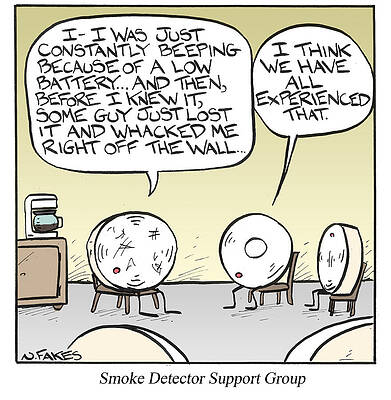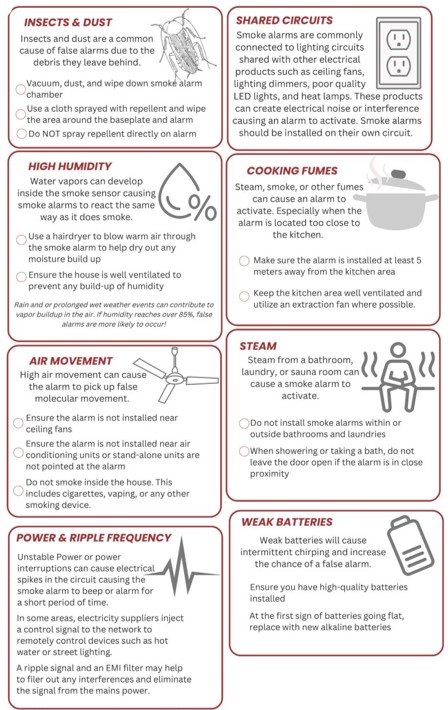Nothing is more frustrating than a smoke detector beeping for no reason—especially in the middle of the night. If you’ve ever been jolted awake at 3 AM by a loud, high-pitched chirping sound, you know just how annoying it can be. But why does this happen? And more importantly, how can you stop it?
Before you rip that smoke alarm off the ceiling in frustration, it’s important to understand why your smoke detector is beeping. While it may seem like an unnecessary nuisance, your smoke alarm is trying to tell you something. Whether it’s a simple issue like dust build-up or a more serious problem requiring immediate attention, this guide will walk you through the most common reasons for a beeping smoke detector and how to fix it.

1. Low Battery – Most Common Cause of a Smoke Detector Beeping
One of the most frequent reasons for a smoke detector beeping intermittently is a low battery. Most traditional battery-operated smoke alarms require battery changes once a year. If the battery is running low, your alarm will emit a short chirp or beep every minute or so as a warning.
How to Fix It:
- If your smoke alarm has a replaceable battery, open the battery compartment and insert a new battery.
- If you have a ZEN Smoke Alarm, you won’t have to worry about this issue! Our alarms come with a non-removable, 10-year lithium battery, eliminating the need for frequent battery changes.
2. High Humidity and Steam Interfering with Your Smoke Detector
Did you know that high humidity can cause your smoke detector to start beeping? Smoke alarms are designed to detect particles in the air, and in very humid conditions, dense moisture particles can trick the sensor into thinking there is smoke present.
Common Causes:
- Steamy showers or baths
- Drying clothes in a poorly ventilated laundry room
- Living in a tropical or extremely humid environment
How to Fix It:
- Relocate the smoke alarm away from steamy areas such as bathrooms and laundries.
- Ensure proper ventilation in rooms where humidity builds up.
- If you live in a humid climate, consider a model such as ZEN which is designed to withstand high humidity levels.
3. Dust Build-up Inside the Smoke Alarm
Over time, dust and debris can accumulate inside the smoke detector’s sensor chamber, disrupting its ability to function correctly. If dust particles block the photoelectric sensor, the alarm may think it’s detecting smoke, causing a false alarm.
How to Fix It:
- Use a vacuum cleaner with a soft brush attachment to gently clean around the alarm.
- Wipe around the alarm with a dry, clean cloth.
- Avoid installing smoke alarms near dusty areas, such as workshops or garages.
4. Insects Crawling Into the Smoke Detector
Believe it or not, small insects can get inside your smoke alarm and trigger a smoke detector beeping. While smoke detectors are designed with mesh screens to prevent large debris from entering, tiny insects can sometimes crawl into the sensing chamber and interfere with the photoelectric light beam.
How to Fix It:
- Use surface insect spray around the ceiling where your smoke alarm is installed (but be very careful not to spray directly onto or into the alarm).
- Regularly clean your smoke detector to prevent cobweb buildup.
- Ensure the alarm is securely mounted to minimize gaps where insects can enter.
5. Cooking Vapours Can Be the Cause of a Smoke Detector Beeping
Cooking is a leading cause of smoke detector beeping. If your smoke alarm is too close to the kitchen, smoke from cooking food—even something as simple as burnt toast—can be the cause of a smoke detector beeping.
How to Fix It:
- If possible, install the smoke alarm at least 3 meters away from cooking appliances.
- Use an exhaust fan or rangehood while cooking to disperse smoke and vapors.
- If your smoke alarm is constantly triggered by cooking, consider relocating it slightly further from the kitchen area.
6. End of Smoke Alarm Lifespan
Like any electronic device, smoke alarms don’t last forever. Most smoke detectors have a lifespan of 10 years, after which they should be replaced. If you notice your smoke detector beeping, even after troubleshooting common causes, it may be time for a new one.
How to Fix It:
- Check the manufacture date on the back of the alarm.
- If the alarm is 10 years old or older, replace it immediately.
- Choose a reliable, long-lasting model like ZEN Smoke Alarms, which come with a built-in 10-year battery and don’t require replacements during their lifespan.
7. Interconnected Smoke Alarms Alerting the Whole Home
If you have wireless interconnected smoke alarms, a smoke detector beeping from one unit may actually be a signal from another unit in the house detecting an issue. Interconnected alarms are designed to sound in unison for full-home protection, which is great for fire safety—but it can also make it harder to determine which alarm triggered the warning.
How to Fix It:
- Identify the source alarm by checking which one activated first.
- Press the silence button once and all alarms should silence except for the source alarm.
- If false alarms persist, check for issues like dust, humidity, or nearby steam sources affecting one unit.
How to Prevent a Smoke Detector Beeping in the Future
To avoid dealing with a smoke detector beeping for no reason, follow these maintenance tips:
✔️ Test your smoke alarms monthly by pressing the test button.
✔️ Clean them regularly using a vacuum or dry cloth to remove dust.
✔️ Avoid placing alarms too close to kitchens, bathrooms, and vents.
✔️ Replace alarms every 10 years to ensure optimal performance.
✔️ Choose high-quality, reliable smoke alarms like ZEN Smoke Alarms to minimize false alarms and maximize protection.
Final Thoughts: Stay Safe and Reduce False Alarms
While a smoke detector beeping may seem like an annoyance, it’s actually an important safety feature designed to keep you and your family safe. By understanding the causes and solutions, you can ensure your smoke alarms function correctly without unnecessary disruptions.
If you’re tired of dealing with constant beeping and unreliable smoke alarms, consider upgrading to ZEN Smoke Alarms. Our wireless interconnected photoelectric smoke alarms are compliant with Queensland’s 2027 smoke alarm laws, feature a non-removable 10-year battery, and are designed to provide hassle-free fire protection for years to come.
Looking for a stress-free smoke alarm solution? Order your ZEN Smoke Alarms today and enjoy reliable, long-lasting fire safety for your home!
For more info regarding a smoke detector beeping – please refer to the smoke alarms diagnostic checklist below!


Want to know more? Watch our ZEN Smoke Alarm YouTube channel or call us on 0478 596 402 today
We love talking smoke alarms!
ZEN Interconnected Smoke Alarms
New Farm, QLD, 4005

